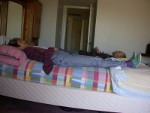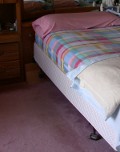|
|
Interestingly, but after doing all of the above, I found "Nocturnal Leg Cramps", a review paper by Monderer, Wu and Thorpy in the January 2010 issue of Current Neurology and Neuroscience Reports (PMID20423227). Under Treatment, is the statement, "Other nonpharmacologic measures that have been proposed include raising the head of the bed and raising the feet on pillows, although neither of these methods has been evaluated formally." A great deal of attention is given prior to this regarding evaluation and even more afterward to pharmacological treatments. The conclusion of the paper is short and begins:
"Nocturnal leg cramps are a common problem that may
adversely affect sleep. Although most cases are idiopathic,
nocturnal cramps may be associated with a wide range of
underlying conditions, many of which are treatable. Although
benign and possibly worthwhile for some, nonpharmacologic
methods of preventing leg cramps have not been proven
effective for most people."
Note the logic disconnect between the first statement regarding raising the head of the bed (or raising the feet on pillows) with "neither of these methods has been evaluated formally" and the conclusion that "nonpharmacologic methods of preventing leg cramps have not been proven effective for most people." The authors appear to be equating "unproven" with "unevaluated", whereas the attributes of proven/unproven should not even apply until experimentation has been done.
The bias towards pharmacologic treatment is obvious with the last sentence in the Conclusion:
"Additional, larger studies are needed to identify a medication that is both safe and effective in treating and preventing nocturnal leg cramps."
It appears to me that the authors of this paper are not interested in anything but phamacologic treatments. And given the fact that pharmaceutical companies fund much of the health related research, it can be seen that none of them would fund anything that is not related to a drug. However maybe an adjustable bed manufacturer would recognize a market potential for a bed with hydraulics at the foot and head of a bed to enable easy raising/lowering of either end depending on the customer's needs. (From my search recently online I do not see this feature, but mostly various back curvature/raising arrangements, some with ability to notch up the knees, that enables the user to sit up in bed, supposedly for respiratory/gastric reflux reasons and/or simply to read or watch TV.) A well-designed study on the actual effects in the population with leg cramps of raising the bed head should produce good data. Tempur-Pedic, Legget and Platt, Sleep-Comfort and Select Comfort (our adjustably inflatable bed in AZ), etc - are you listening?!!
|

 To make the sleeping arrangement better so as to promote fluid drainage in Paul's legs while he sleeps and because he is more comfortable in a flat position rather than V-shaped with his legs up, I also changed the top sheeting so that we each have separate single top sheets and separate blankets. His were arranged with his head at the "foot" of the bed (about 5" lower than the very head of the bed, because the foot caster pivot point is a ways "up" from the foot of the bed). The photo I took of us lying in our respective positions gives an idea of how it looks, along with the close-up of the block arrangement.
To make the sleeping arrangement better so as to promote fluid drainage in Paul's legs while he sleeps and because he is more comfortable in a flat position rather than V-shaped with his legs up, I also changed the top sheeting so that we each have separate single top sheets and separate blankets. His were arranged with his head at the "foot" of the bed (about 5" lower than the very head of the bed, because the foot caster pivot point is a ways "up" from the foot of the bed). The photo I took of us lying in our respective positions gives an idea of how it looks, along with the close-up of the block arrangement.